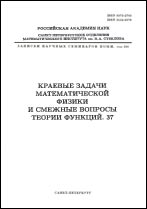|
|
Zapiski Nauchnykh Seminarov POMI, 2008, Volume 360, Pages 31–69
(Mi znsl2158)
|
 |
|
 |
This article is cited in 1 scientific paper (total in 1 paper)
Instability, complexity, and evolution
S. Vakulenkoab, D. Grigorievc
a Institute of Problems of Mechanical Engineering, Russian Academy of Sciences
b North Western Institute of Printing, St. Petersburg State University of Technology and Design
c Université de Lille
Abstract:
In this paper, we consider a new class of random dynamical systems which contains in particular neural networks and complicated circuits. For these systems we consider the viability problem: we suppose that the system survives only if the system state is in a prescribed domain $\Pi$ of a phase space. The approach developed here is based on some fundamental ideas proposed by A. Kolmogorov, R. Thom, M. Gromov, L. Valiant, L. Van Valen, and others.
Under some conditions it is shown that almost all systems from this class with fixed parameters are unstable in the following sense: the probability $P_t$ to leave $\Pi$ within time interval $[0,t]$ tends to 1 as $t\to\infty$. However, if it is allowed to change these parameters sometimes (“evolutionary” case), then possibly that $P_t<1-\delta<1$ for all $t$ (“stable evolution”). Furthermore we study the properties of such stable evolution assuming that the system parameters are coded by a dicsrete code. This allows us to apply the complexity theory, coding, algorithms etc. Evolution is a Markov process of this code modification. Under some conditions we show that the stable evolution of unstable systems possesses such general fundamental property: the relative Kolmogorov complexity of the code cannot be bounded by a constant as time $t\to\infty$. For circuit models we define complexity characteristics of these circuits. We find that these complexities also have a tendency to increase during stable evolution. We give concrete examples of stable evolution. Bibl. – 80 titles.
Received: 02.12.2008
Citation:
S. Vakulenko, D. Grigoriev, “Instability, complexity, and evolution”, Representation theory, dynamics systems, combinatorial methods. Part XVI, Zap. Nauchn. Sem. POMI, 360, POMI, St. Petersburg, 2008, 31–69; J. Math. Sci. (N. Y.), 158:6 (2009), 787–808
Linking options:
https://www.mathnet.ru/eng/znsl2158 https://www.mathnet.ru/eng/znsl/v360/p31
|

| Statistics & downloads: |
| Abstract page: | 375 | | Full-text PDF : | 107 | | References: | 50 |
|




 Contact us:
Contact us: Terms of Use
Terms of Use
 Registration to the website
Registration to the website Logotypes
Logotypes








 Citation in format
Citation in format 
